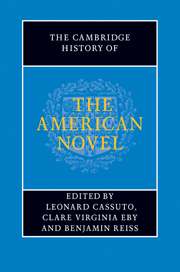Book contents
- Frontmatter
- General Introduction
- PART ONE INVENTING THE AMERICAN NOVEL
- PART TWO REALISM, PROTEST, ACCOMMODATION
- Introduction: realism, protest, accommodation
- 17 Realism and radicalism: the school of Howells
- 18 James, pragmatism, and the realist ideal
- 19 Theories of the American novel in the age of realism
- 20 The novel in postbellum print culture
- 21 Twain, class, and the Gilded Age
- 22 Dreiser and the city
- 23 Novels of civic protest
- 24 Novels of American business, industry, and consumerism
- 25 New Americans and the immigrant novel
- 26 Cather and the regional imagination
- 27 Wharton, marriage, and the New Woman
- 28 The postbellum race novel
- 29 The African American novel after Reconstruction
- 30 The rise of naturalism
- 31 Imagining the frontier
- 32 Imperialism, Orientalism, and empire
- 33 The hemispheric novel in the post-revolutionary era
- 34 The woman's novel beyond sentimentalism
- 35 Dime novels and the rise of mass-market genres
- 36 Readers and reading groups
- PART THREE MODERNISM AND BEYOND
- PART FOUR CONTEMPORARY FORMATIONS
- A selected bibliography
- Index
Introduction: realism, protest, accommodation
from PART TWO - REALISM, PROTEST, ACCOMMODATION
Published online by Cambridge University Press: 28 July 2011
- Frontmatter
- General Introduction
- PART ONE INVENTING THE AMERICAN NOVEL
- PART TWO REALISM, PROTEST, ACCOMMODATION
- Introduction: realism, protest, accommodation
- 17 Realism and radicalism: the school of Howells
- 18 James, pragmatism, and the realist ideal
- 19 Theories of the American novel in the age of realism
- 20 The novel in postbellum print culture
- 21 Twain, class, and the Gilded Age
- 22 Dreiser and the city
- 23 Novels of civic protest
- 24 Novels of American business, industry, and consumerism
- 25 New Americans and the immigrant novel
- 26 Cather and the regional imagination
- 27 Wharton, marriage, and the New Woman
- 28 The postbellum race novel
- 29 The African American novel after Reconstruction
- 30 The rise of naturalism
- 31 Imagining the frontier
- 32 Imperialism, Orientalism, and empire
- 33 The hemispheric novel in the post-revolutionary era
- 34 The woman's novel beyond sentimentalism
- 35 Dime novels and the rise of mass-market genres
- 36 Readers and reading groups
- PART THREE MODERNISM AND BEYOND
- PART FOUR CONTEMPORARY FORMATIONS
- A selected bibliography
- Index
Summary
In William Dean Howells's exemplary realist novel A Hazard of New Fortunes (1890), German-American socialist Berthold Lindau sounds a voice of pure protest, underscoring how more complacent (if well-intentioned) liberal characters accommodate rather than contest the ascendant capitalist masters. Choosing to live in poverty, missing a hand from his Civil War service, and speaking in heavily accented English, Lindau embodies the fracturing of late nineteenth-century America into multiple populations based on class, ethnicity, politics, and region of origin. Hazard suggests Howells's ambivalence as to whether such differences could ever be overcome and fear that socioeconomic power would increasingly be concentrated in fewer and fewer hands. Yet Lindau also personifies Howells's hope that realism might provide, as Michael Elliott notes in the opening chapter in this section, a “salutary engine for change.” For all of these reasons, Lindau provides an effective introduction to the issues informing this section.
As both Lawrence Buell and Barbara Hochman document in their chapters, the American novel gained unprecedented prestige during the late nineteenth and early twentieth centuries. If the novel had serious work to do, then certainly protest was an important part of that work. Cecelia Tichi delineates a tradition of “civic protest” and asks that we make a place for the role of propaganda in literary studies, while Tim Prchal proposes we read immigrant novels for “what they hope to reform or, indeed, what they argue against.”
- Type
- Chapter
- Information
- The Cambridge History of the American Novel , pp. 283 - 288Publisher: Cambridge University PressPrint publication year: 2011

